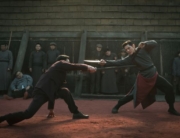
Broom, broom, broom; screech. Bang.
The sound design for the racing car epic Ford v Ferrari envelops the viewer. No matter if the viewer is a novice or a circuit insider, the racing scenes—the film’s strongest selling point—will hold the viewer’s attention hostage. (Although the sound levels in this movie are loud, they are nowhere as assaultive as those in another film opening this week, Waves.)
Additionally, the camera embeds the viewer in the driver’s seat, with high-octane sequences often filmed from the driver’s point of view and shot with a widescreen lens ideal for this movie—most of the action unfurls horizontally at hundreds of miles per hour. As cars crash and debris and tires fly in the air, you can’t help but ask, why wasn’t this made in 3-D?
Away from the race track, the film centers on the low-key, breezy rapport between its two stars—and this is definitely a star vehicle, pun intended, for Matt Damon and Christian Bale. Both are typecast in roles that offer few departures from their screen personas: Damon, with his calm, cool, and cocky earnestness, and Bale as the wildcard, someone on his own wavelength, volatile but approachable, similar to his unpredictable trainer in The Fighter. Damon so underplays his part that his main means of communicating Shelby’s nervousness is by how fast he cracks his gum—a technique out of the Wrigley School of Acting. Just as the microphones pick up every screech, collision, and shattering of glass, they also pick up every snap, crackle, and pop.
Still, surprises arise out of the twists and turns (off and on the track) in this account of the Ford Motor Company’s attempts to compete with the big boys on the racing circuit and beat marquee manufacturer Ferrari. In 1964, Henry Ford II hires former champion racer Carroll Shelby (Damon) to design the world’s fastest car, and gives the Texan a blank check to build it in 90 days’ time for the prestigious Le Mans, a 24-hour race down French country roads with no guardrails. Shelby has sworn off racing on doctor’s orders because of the risk of cardiac arrest. In his stead, he handpicks his favorite driver, the only one he feels is up to the Herculean task, the British Ken Miles (a jut-jawed Bale).
At 45, Miles has thrown out his trophies and hunkered down to provide a stable income for his wife and adoring son, Peter, played by Noah Jupe, who looks remarkably like a little Freddie Bartholomew. As Henry Ford II, Tracy Letts is also out of Central Casting as the imperial and braggart executive, struggling to venture free from the shadow of his grandfather, Henry Ford. As the ruler of his own industrial fiefdom, he doesn’t even have to look at his underlings in the eye, but instead stares out of the window, barking orders.
If the racing scenes give off a you-are-there sensation, the rest of the movie doesn’t leave you in the dust either. The planning for victory at Le Mans is just as important as the actual race, though director James Mangold saves the most exciting section, the actual competition, for last. Until then, the screenplay delves into corporate intrigue, including Ford’s attempt to buy out Ferrari, boardroom battles, and the development of the Ford GT40. It’s a long and twisted road to France.
The screenwriters trust the material enough to focus on the bond between Shelby and Miles, and for the most part they succeed. Only occasionally does the movie go overboard and forcefully grab viewers’ attention, namely in a marriage squabble between Miles and his wife, Mollie (Catriona Balfe), a mid-sixties Cool Girl who can car-talk with the boys. Knowing that Miles has lied to her about joining the racing project, she flips out, forcing Miles to tell her the truth as she steers the family car on an erratic, life-threatening course down a winding street packed with other motorists. The film already provides enough white-knuckle thrills.
With racing sequences sprinkled throughout, the narrative is well-paced. Even with the bells and whistles of the numerous races, the script narrows down to a two-hander drama between Shelby and Miles against the hard-edged corporate mind-set at Ford, where Shelby will have to stick his neck out to protect Miles from being replaced; the executive director of the racing program, Leo Beebe (a smarmy Josh Lucas), believes Miles is too much of a renegade and not enough of a Ford man. Though Shelby and Miles aren’t exactly counterculture types, they’re not suit and tie either. (The less you know about the results of the 1966 Le Mans race beforehand, the better.)
Filmed with minimal special effects, the film has an analog feel to it. There is no green screen, and the cameras are planted within the speeding sports cars. It brings to mind the sort of buddy movies that starred Robert Redford and Paul Newman or Burt Reynolds and Jerry Reed—at one point, this project was meant for Tom Cruise and Brad Pitt. Though it has been rated a too-cautious PG-13 for strong language and peril, the movie offers, to quote Miss Somerset from Thornton Wilder’s 1942 play The Skin of Our Teeth, “good entertainment with a message you can take home with you.”






Leave A Comment